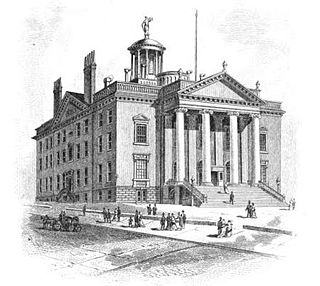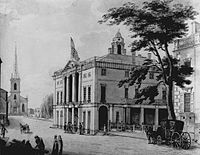Background
Under the provisions of the New York Constitution of 1777, the state senators were elected on general tickets in the senatorial districts, and were then divided into four classes. Six senators each drew lots for a term of 1, 2, 3 or 4 years and, beginning at the election in April 1778, every year six Senate seats came up for election to a four-year term. Assemblymen were elected countywide on general tickets to a one-year term, the whole assembly being renewed annually.
In March 1786, the legislature enacted that future legislatures meet on the first Tuesday of January of each year unless called earlier by the governor. No general meeting place was determined, leaving it to each Legislature to name the place where to reconvene, and if no place could be agreed upon, the legislature should meet again where it adjourned.
On February 7, 1791, the Legislature re-apportioned the Senate and Assembly districts, according to the figures of the United States Census of 1790. The area of Columbia and Rensselaer counties were transferred from the Western to the Eastern District; and the Southern and the Western districts lost one senator each, which were added to the Eastern District. The total number of assemblymen was again set at 70; but several new counties were established: Herkimer (1 seat), Ontario (1), Otsego (1), Rensselaer (5), Saratoga (4) and Tioga (1); Kings, Orange, Queens, Richmond, Suffolk, Ulster and Westchester lost 1 seat, and Montgomery and New York lost 2; and Columbia won 3 seats.
At this time the politicians were divided into two opposing political parties: the Federalists and the Democratic-Republicans. [1] Party lines were not as distinctly drawn then as they became during the 19th century. Some politicians changed sides, for example the Livingston faction of the Federalist Party who felt betrayed after the election of Rufus King over their candidate James Duane in the 1789 United States Senate elections in New York and later voted down Schuyler for re-election in 1791.

The 14th New York State Legislature, consisting of the New York State Senate and the New York State Assembly, met from January 5 to March 24, 1791, during the fourteenth year of George Clinton's governorship, in New York City.

The 16th New York State Legislature, consisting of the New York State Senate and the New York State Assembly, met from November 6, 1792, to March 12, 1793, during the sixteenth year of George Clinton's governorship, in New York City.

The 17th New York State Legislature, consisting of the New York State Senate and the New York State Assembly, met from January 7 to March 27, 1794, during the seventeenth year of George Clinton's governorship, in Albany.

The 18th New York State Legislature, consisting of the New York State Senate and the New York State Assembly, met from January 6 to April 9, 1795, during the eighteenth year of George Clinton's governorship, first in Poughkeepsie, then in New York City.

The 19th New York State Legislature, consisting of the New York State Senate and the New York State Assembly, met from January 6 to April 11, 1796, during the first year of John Jay's governorship, in New York City.

The 20th New York State Legislature, consisting of the New York State Senate and the New York State Assembly, met from November 1, 1796, to April 3, 1797, during the second year of John Jay's governorship, first in New York City, then in Albany.

The 21st New York State Legislature, consisting of the New York State Senate and the New York State Assembly, met from January 2 to April 6, 1798, during the third year of John Jay's governorship, in Albany.

The 22nd New York State Legislature, consisting of the New York State Senate and the New York State Assembly, met from August 9, 1798, to April 3, 1799, during the fourth year of John Jay's governorship, in Albany.

The 24th New York State Legislature, consisting of the New York State Senate and the New York State Assembly, met from November 4, 1800, to April 8, 1801, during the sixth year of John Jay's governorship, in Albany.

The 25th New York State Legislature, consisting of the New York State Senate and the New York State Assembly, met from January 26 to April 5, 1802, during the first year of George Clinton's second tenure as Governor of New York, in Albany.

The 26th New York State Legislature, consisting of the New York State Senate and the New York State Assembly, met from January 25 to April 6, 1803, during the 2nd year of George Clinton's second tenure as Governor of New York, in Albany.

The 27th New York State Legislature, consisting of the New York State Senate and the New York State Assembly, met from January 31 to April 11, 1804, during the third year of George Clinton's second tenure as Governor of New York, in Albany.

The 28th New York State Legislature, consisting of the New York State Senate and the New York State Assembly, met from November 6, 1804, to April 10, 1805, during the first year of Morgan Lewis's governorship, in Albany.

The 30th New York State Legislature, consisting of the New York State Senate and the New York State Assembly, met from January 27 to April 7, 1807, during the third year of Morgan Lewis's governorship, in Albany.

The 33rd New York State Legislature, consisting of the New York State Senate and the New York State Assembly, met from January 30 to April 6, 1810, during the third year of Daniel D. Tompkins's governorship, in Albany.

The 34th New York State Legislature, consisting of the New York State Senate and the New York State Assembly, met from January 29 to April 9, 1811, during the fourth year of Daniel D. Tompkins's governorship, in Albany.

The 36th New York State Legislature, consisting of the New York State Senate and the New York State Assembly, met from November 3, 1812, to April 13, 1813, during the sixth year of Daniel D. Tompkins's governorship, in Albany.

The 38th New York State Legislature, consisting of the New York State Senate and the New York State Assembly, met from September 26, 1814, to April 18, 1815, during the eighth year of Daniel D. Tompkins's governorship, in Albany.

The 40th New York State Legislature, consisting of the New York State Senate and the New York State Assembly, met from November 5, 1816, to April 15, 1817, during the tenth year of Daniel D. Tompkins's governorship, and while John Tayler was Acting Governor, in Albany.

The 43rd New York State Legislature, consisting of the New York State Senate and the New York State Assembly, met from January 4 to April 14, 1820, during the third year of DeWitt Clinton's governorship, in Albany.




